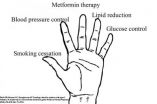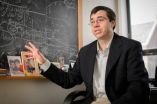(Press-News.org) Scottsdale, Ariz., February 20, 2014—For head and neck cancer patients undergoing radiation therapy, a reduction in the amount of radiation treatment volume to the submandibular (level IB) lymph nodes resulted in better patient-reported salivary function, according to research presented today at the 2014 Multidisciplinary Head and Neck Cancer Symposium. The study results also found significant reductions in radiation dose to the salivary organs, and good local regional control.
Researchers evaluated 125 patients with node-positive oropharyngeal cancer who received chemoradiation at Memorial Sloan-Kettering Cancer Center in New York between May 2010 and December 2011. The average patient age was 57. Fifty-one percent of patients had base of tongue lesions; 41 percent had tonsil cancer; and 6 percent were classified as "other." The breakdown of patients' cancer stage/classification was: 74 percent T1-2 and 26 percent T3-4. All patients had cancer with lymph node involvement, including 16 percent N1; 8 percent N2A; 48 percent N2B; and 28 percent N2C.
Patients were categorized into two groups: those with sparing, or a reduction of radiation treatment volume to the region, of bilateral level IB nodes and those who underwent treatment without sparing. A prospective questionnaire regarding xerostomia (dry mouth) to assess late xerostomia was given to patients in both groups at each patient follow-up visit; clinical assessment (observer-rated) xerostomia scores were also recorded.
The participants who received treatment involving sparing experienced significant improvement in patient-reported xerostomia summary scores (p=0.021) and observer-rated xerostomia scores (p=0.006) over the group in which there was no sparing. The two-year local regional control rate for the spared group was 97.5 percent and 93.8 percent for the group treated, indicating a low rate of cancer recurrence at the original tumor site.
Additionally, study results showed reductions in the mean radiation doses to the mouth and neck regions of patients in the spared group over the group with no sparing, including the ipsilateral submandibular gland (63.9 Gy vs. 70.5 Gy; p END
Reducing RT dose to bilateral IB lymph nodes results in better patient-reported salivary function
2014-02-20
ELSE PRESS RELEASES FROM THIS DATE:
Unilateral radiation therapy for advanced stage tonsil cancer results in favorable outcomes
2014-02-20
Scottsdale, Ariz., February 20, 2014—Limiting radiation therapy to lymph nodes on one side of the neck for advanced tonsil cancer resulted in good local regional control and no cancer recurrence on the untreated side, according to research presented today at the 2014 Multidisciplinary Head and Neck Cancer Symposium. Additionally, the study results indicate that primary tumor location, rather than the amount of lymph node involvement on the tumor side of the neck, dictates the risk for disease in the opposite side of the neck.
The study focused on 46 out of 153 total patients ...
MATH, HPV status in HNSCC patients effective markers of improved patient outcome
2014-02-20
Scottsdale, Ariz., February 20, 2014—Evaluating next-generation sequencing (NGS) data and associated clinical records of head and neck squamous cell carcinoma (HNSCC) patients from several institutions, made available through The Cancer Genome Atlas (TCGA), showed that combining Mutant-Allele Tumor Heterogeneity (MATH) as a biomarker with the patient's HPV status provides an effective indicator of improved patient outcome, according to research presented today at the 2014 Multidisciplinary Head and Neck Cancer Symposium.
The TCGA data available for HNSCC patients included ...
Rural primary care physicians are committed to professionalism, quality improvement
2014-02-20
The increased demand for primary care services expected to result from the Affordable Care Act (ACA) may be felt strongly in rural areas. While studies have found that the quality of care delivered to rural patients is as good or better than that available in urban areas, the belief persists that top-quality primary care is only available in big cities. But a new study appearing in the National Rural Health Association's Journal of Rural Health finds few meaningful differences between rural and urban primary care physicians on key measures of professionalism, including ...
Study examines correctional officer stress
2014-02-20
HUNTSVILLE, TX (2/20/14) -- Conflicts between work and family life were the most significant issues that affect work stress and job satisfaction among correctional officers, a new study by the Correctional Management Institute of Texas at Sam Houston State University found.
In a study of 441 correctional officers from adult prisons in the South, the most significant work-home issues experienced by correctional officers were demands and tensions from work that impact their home life; an incompatibility between the officer's role at work and at home; and family circumstances ...
Meet your match: Using algorithms to spark collaboration between scientists
2014-02-20
Speed dating, in which potential lovers size each other up in brief 10 minute encounters before moving on to the next person, can be an awkward and time-wasting affair. Finding the perfect research partnership is often just as tough. Speed dating-style techniques are increasingly used at academics conferences, but can be equally frustrating - with busy academics being pushed into too many pointless encounters.
But now a group of scientists led by geneticist Rafael Carazo Salas have constructed a system that could revolutionise conference speed dating - by treating scientists ...
Editorial illustrates shift away from glycemic control in diabetes treatment
2014-02-20
BOSTON (February 20, 2014)—An editorial in a February issue of American Family Physician proposes a simple way for physicians to communicate with patients about the best treatments for diabetes. The "lending a hand" illustration reprioritizes treatment goals, based on research on mortality reduction, to convey that glycemic control is no longer the primary intervention.
In order of benefit, to improve length and quality of life, patients with type 2 diabetes benefit from these interventions, starting with smoking cessation:
"Glycemic control is stuck in people's minds ...
Why are some children more resilient to post-traumatic stress?
2014-02-20
New Rochelle, NY, February 20, 2014—Children exhibit a range of responses to traumatic events such as natural disasters, with some suffering acute traumatic reactions that resolve over time and others experiencing long-term symptoms of post-traumatic stress. Identifying factors that may help predict which youths are at greater risk of more serious disorders and which are likely to be more resilient following a traumatic event can help determine the care and services needed, according to an article in Journal of Child and Adolescent Psychopharmacology (JCAP), a peer-reviewed ...
What is El Nino Taimasa?
2014-02-20
During very strong El Niño events, sea level drops abruptly in the tropical western Pacific and tides remain below normal for up to a year in the South Pacific, especially around Samoa. The Samoans call the wet stench of coral die-offs arising from the low sea levels "taimasa" (pronounced [kai' ma'sa]). Studying the climate effects of this particular variation of El Niño and how it may change in the future is a team of scientists at the International Pacific Research Center, University of Hawai'i at Mānoa and at the University of New South Wales, Australia.
Two El ...
Remote Antarctic telescope reveals gas cloud where stars are born
2014-02-20
Using a telescope installed at the driest place on earth - Ridge A in Antarctica – a UNSW-led team of researchers has identified a giant gas cloud which appears to be in an early stage of formation.
Giant clouds of molecular gas – the most massive objects in our galaxy – are the birthplaces of stars.
"This newly discovered gas cloud is shaped like a very long filament, about 200 light years in extent and ten light years across, with a mass about 50,000 times that of our sun," says team leader, Professor Michael Burton, an astronomer at UNSW Australia.
"The evidence suggests ...
With friends like these, who needs democracy?
2014-02-20
EAST LANSING, Mich. — From Ethiopia to Nicaragua, countries that go through civil war are much less likely to become democratic if the winning side gets help from rival nations, a Michigan State University political scientist argues.
In a new study examining democratization after civil wars since World War II, Michael Colaresi found the majority of groups that eventually took power failed to establish democratic governments if those groups took money or weapons from a foreign enemy during the war.
Receiving such aid can create mistrust among the nation's citizens and ...




